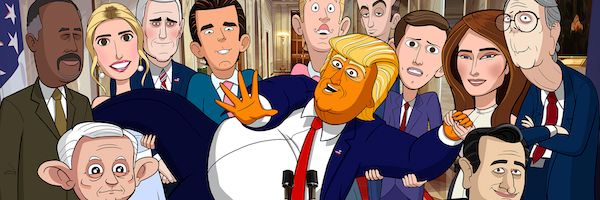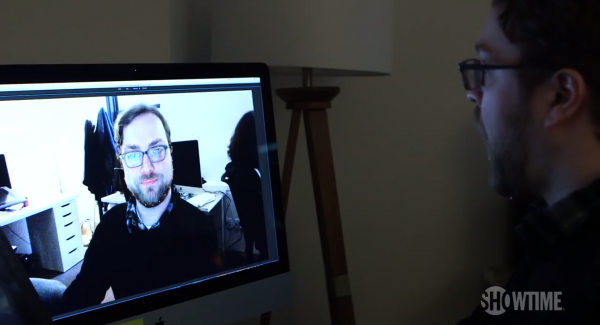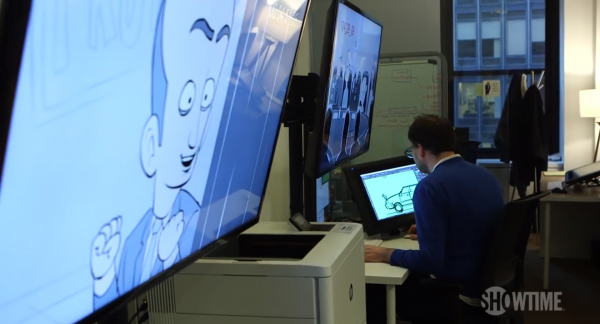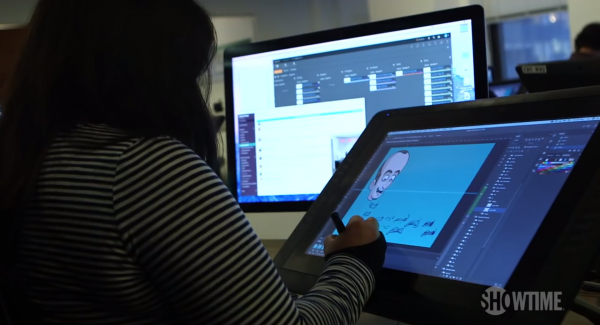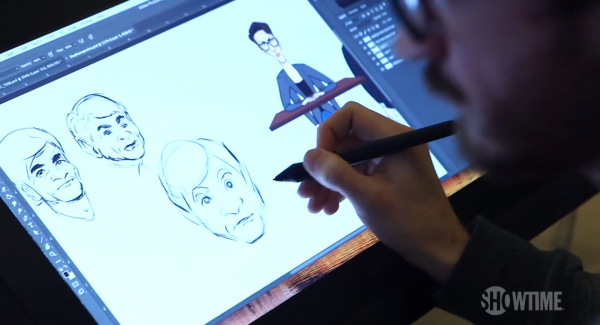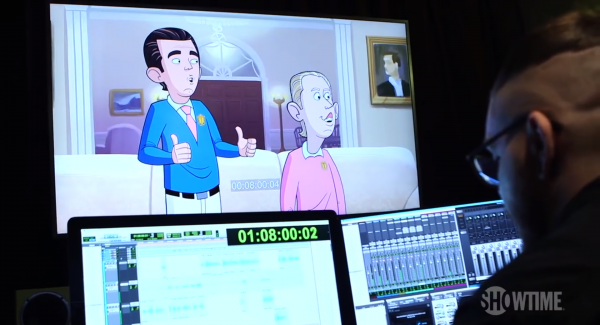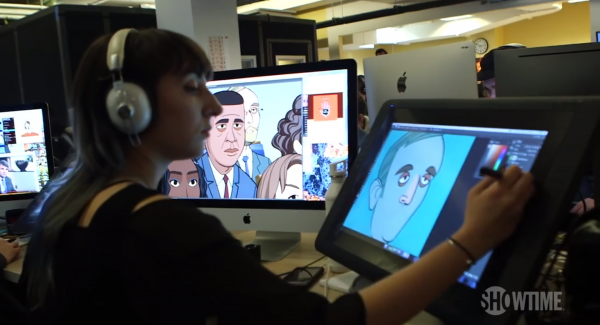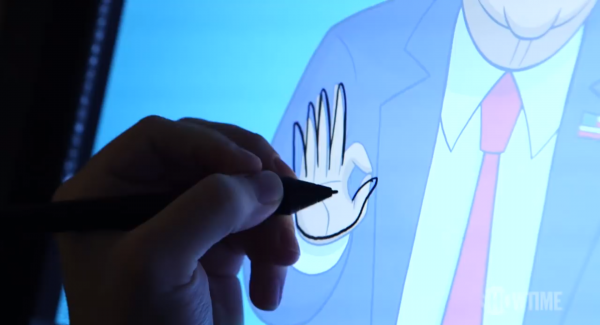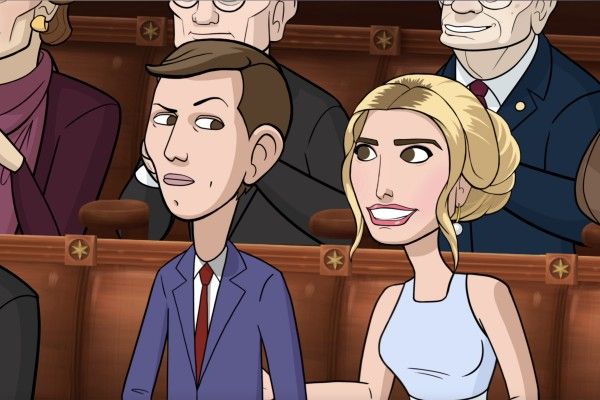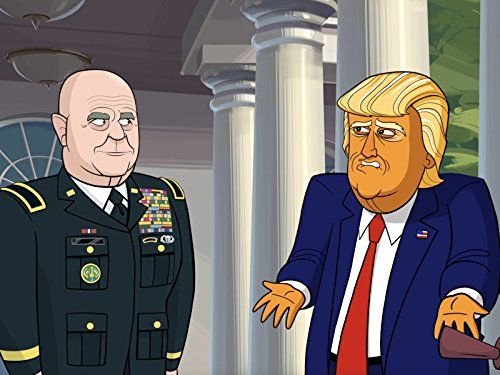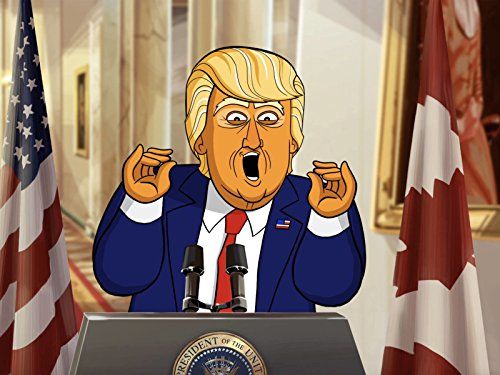It's rarely difficult to differentiate between the real world and that of animated comedy series. Not so in Showtime's Our Cartoon President, a show that takes the cartoonish characters of President Donald Trump and his administration and animates them in real-time in order to offer comedic commentary on their often incomprehensible actions. As the stranger-than-fiction story of the Trump administration continues to unfold, the surreal experience of bringing Our Cartoon President to life is both a blessing and a curse for the show's co-creator Tim Luecke.
I chatted with Luecke, the lead animator, writer, and co-executive producer of the series, about the crazy production timeline for the show, the use of Adobe Character Animator CC and its lip-sync technology as an essential tool in bringing it to life, and the cognitive dissonance he and his team experiences on a daily basis by satirizing the already bizarro real-world personalities as bigger-than-life characters. It's a fascinating conversation that hardcore animation fans and artists should enjoy, but it also gives more casual fans a peek behind the curtains of one of the zaniest animated series on TV today. Additionally, seven new episodes of Our Cartoon President are confirmed to arrive on Showtime this summer, so Luecke teases what the team has in store for fans.
But before we get into the detailed breakdown, here's a solid introductory look behind the scenes of production:
For folks who aren’t familiar with Our Cartoon President, how would you describe it to them?
Tim Luecke: It takes place in a sort of crazy reality where Donald Trump has become the President of the United States. We start with that as our premise. If I had to describe it in a few words, I’d say it’s “Stupid West Wing.” If you put a lot of bumbling fools in the highest office in the world, that’s sort of what you’d get with Our Cartoon President.
What’s the process of bringing this idea to a full series been like?
Luecke: It happened incredibly organically. This really started as a bit that we did on The Late Show back in 2016, back when it still seemed ridiculous that any of this could happen. We had started using Adobe Character Animator to interview a cartoon version of Donald Trump, who at the time was not yet the nominee, and so we would do these bits that … reality has become so cartoonish that the only way we could possibly engage in a conversation with it is to engage with an actual cartoon character. We found success in those.
I had originally made the Donald Trump cartoon as kind of a test project to learn Character Animator. I never thought that it would find any use beyond one or two bits on the show, if any, but then he kept winning and we had to keep responding. Eventually it got to election night and we thought that we needed to find a new way, a more cinematic way to talk about some of what had gone on in this election and sort of delve into the psyche of Donald Trump and what causes a man like that to seek the attention and power that he does. So myself and Matt Lappin, who is a producer and writer on The Late Show, rather than doing the sort of interview bit that we had been doing, we wanted to create more of a short film and tell what we thought was the origin story of candidate Trump. Many people had pointed to the 2011 Correspondents Dinner where Obama made some jokes at his expense in front of a room of upper-echelon society types, and it’s been posited that that sort of sent him into a spiral and he wanted to prove everyone wrong and basically take Obama’s job.
So Matt and I wanted to do this more cinematic piece, still using Character Animator but using it in a way to tell more of a comic book villain origin story. We took some inspiration from Batman: The Killing Joke and sort of posited that that night was when Trump was thrown into a vat of acid and came out the other side as a super-villain running for president.
Again, we thought that was going to be the last of it. We wrote and produced that from premise to final air-date in 18 days. It was a huge push because it was Matt doing the writing and just me doing the animated, and it was a three-and-a-half minute piece. The only thing that got me through that was knowing that this would be the last big push and then we’d be done with him and I could go back to my normal life. It aired at 11pm Election Night, which was still just about half an hour too soon to know for sure what the results would be, so it became very prescient very quickly.
Actually, in the room we had discussed playing it maybe the day after the election, as one last punch to Trump, but people thought maybe everyone would just want to get away from Trump and never think about him again, so we played it on Election Night. Twenty minutes after it aired, it took on a very different tone. What was supposed to be this comedic comic book story about this terrible man with a bloated ego became more of an ominous look into what the next four years was going to be. That was sort of our transition from doing these lighter, comedic interview bits, to doing something that was a little more narrative and cinematic with the character.
When he actually took office in January, we had sort of proven to ourselves that we could do these short-film style things and we made it a goal to do more of these narrative-style pieces of Trump now that he was occupying the White House. What was going on behind the scenes? What were his conversations with Steve Bannon? Because this was back in the day when he was still relevant.
So we started doing those for a couple of months and they seemed to perform well online. There was a popularity to them. Chris Licht, the showrunner of The Late Show, basically said, “We’ve got this popular segment that you and Matt have been doing. Let’s turn it into its own show. Unfortunately Trump’s not going anyway, so let’s develop this.” So Matt and I created a pitch for Showtime with the characters, basically saying, “This would be behind the scenes at the White House,” and the goal always was to be able to produce it as quickly as we possibly could so that we could begin to keep up with the news cycle.
I’ve always been impressed with South Park’s ability to turn a relevant, contemporary episode around in a week’s time; you guys manage it in 2 days. How is that possible?
Luecke: We have a portion of it that is done basically in a day, the week of; that’s sort of the cold open portion of it ,which ends up being two to three minutes of each episode that’s entirely produced in a day with lots of topical jokes about what happened. And then the bulk of the episode is a narrative. We have about 10 weeks per episode from beginning of scripting to completed episode where we are doing more of a traditional sitcom narrative. Once we get closer to the air date and something like Stormy Daniels happens, which … that news broke about a week or two before our official premiere, so we had to find ways to insert some topical jokes within the bulk of the narrative. This sort of balancing act of how can you create storylines and narratives 10 weeks later, but also leave opportunities within those narratives to comment on what just happened the week that this thing airs.
The other struggle is, how do you write for the characters that you can be relatively confident will be there when the episode airs? We’ve got a graveyard developing of characters that we’ve put a fair amount of effort into designing and animating and have since left the administration. In a large part, that means we keep a lot of episodes focused on the family, because if there’s one group of people that Trump will never fire, it’s his family… wives excluded.
So we just finished the first 10 episodes, and just as they finished airing, General McMaster was on his way out. We all breathed a sigh of relief that we had gotten through 10 episodes with no major casualties until the very end.
Did you ever toy with the idea of producing shorter episodes instead of the traditional half-hour format?
Luecke: I think we were pretty set on the half-hour from the get-go. It was pitched and developed as a workplace comedy. If you look at some of the more recent workplace comedies on TV, they tend to be more of the half-hour route. That said, I think we’ve done a great job of keeping a fast pace to the episode and working in various plot lines in each one. I think the half-hour works well. And then we do get to inject the last-minute topical bits, which keeps it even more on its toes.
How have advances in animation software helped to shorten your production times?
Luecke: I would say that using Adobe Character Animator has made it possible at all to work in the extremely tight production timeline that we’ve chosen. It’s a new piece of software developed by a number of people who developed Adobe After Effects, but it specializes in allowing real-time animation of a previously drawn and rigged puppet. So that’s how we were able to accomplish all the live, real-time interview bits on The Late Show. But then what we found, once we started doing these more narrative pieces--which were animated ahead of time in Adobe Character Animator, not done live—was that you could use this software to very quickly animate, especially, conversational scenes. Once you build the character and have drawn all their facial expressions and their mouth shapes, and created a library of hand gestures that they can do, you can sit down and churn out minutes of conversational animation in a day when previously that would have taken weeks.
So we sort of built the show around that idea. Using Character Animator, we can churn out a lot of comedic conversations very quickly. Then, it becomes a balancing act of X percentage of the show is them in the Cabinet room having a conversation, them in the Oval Office having a conversation, and then Y percentage will be a bigger set piece that we know we have to put a lot more traditional, hand-drawn animation and elbow grease into. The only way to create an episode at twice the speed of a normal production, which is what we’re doing, is to create that balance where a lot of it is getting done in Character Animator; I’d say 80% of the show. And then the other 20% are the set pieces where we do a combination of hand-drawn, frame-by-frame animation in Photoshop and then after effects rigging and key frame animation.
And then the topical pieces, the cold opens, which are produced in a day the week of, there’s no way that would be possible with any other software at this time. That’s been one of my favorite aspects of this show, being able to create a two or three-minute animated piece the week that the episode is going to air, and be able to respond to something that has just happened in the news, or place our characters at an event that’s happening that weekend, such as the Oscars. That’s where the adrenaline rush kicks in for me, doing these quick turn-around animation pieces. Animation is a slow, laborious process, but it’s been fun for the team to, all hands on deck, throw something together and then reap the benefits two days later.
Is the animation software purely driven by audio or text input, or is there facial tracking from the voice actors? How much is an animator selecting mouth shapes frame by frame?
Luecke: It’s very much a balance. Character Animator has a lot of motion-tracking features and live lip-sync computation feature, that’s what we used on The Late Show. The facial-tracking was happening in real-time on The Late Show and all the lip-sync was happening in real-time. For this show, because we have just slightly more time to perfect things than we did on The Late Show, we still use the automatic lip-sync computation, which will take an actor’s previously recorded VO and lay down a lip-sync pass, basically. But we still have animators to go in and meticulously refine that lip-sync to make sure that it matches up frame by frame; there’s still the animator’s hand in the lip-sync.
With the facial tracking system, that’s been one of the big hurdles of this series. We’re the first people to attempt to do a series with Character Animator and it’s a very drawn-looking show, there’s a lot of hand-drawn elements to it, so it’s been a balance of finding how to use the facial-tracking feature but still make things seem like they’re, in a way, traditionally animated. So we have animators using the facial-tracking but they’ll try to pair it with the character doing a gesture or changing their facial expression and try to hit a look with the facial-tracking that looks like something that you would see in a traditionally animated show.
There are a few different methods to do that: Some people use the facial-tracking more in a stop-motion style and basically take photographs of their face in different positions and then allow the software to compute that to a full performance. It’s a very cool blend of traditional animation, a lot of hand-drawn frame-by-frame animation that goes into the faces and the arm gestures, and then there’s this added component down the line of this new technology of facial-tracking. So it creates a real hybrid that allows us to pay tribute to hand-drawn animation but still allows us to create a product in a timeline that is extremely quick and allows us to be topical.
Are there any characters who are particularly easy or difficult to animate?
Luecke: I would say there are certainly some who are more fun than others. Ted Cruz has sort of become this vaguely supernatural, demon-like, frog creature in our show.
In real life, you mean?
Luecke: It’s hard to make the distinction sometimes. He’s voiced by James Adomian, who just brings this fantastic, manic vocal performance, so one of the joys of this show was trying to make sure that the animation for Ted Cruz matches his vocal performance. I would also say Don and Eric, the two boys who are sort of the Beavis and Butthead of our show and our nation. They’re a lot of fun just because their characters are so crystallized in our show. Don Jr. is just such a hopeless bro who brings no depth to any conversation. Eric is sort of the one vaguely innocent being in our world; he has a childlike innocence that perhaps is too kind to him, but it creates this nice contrast against all the other characters, that there’s sort of this one childlike character still in the room who doesn’t understand how terrible everything that everyone else is doing is.
Are there any characters in the graveyard that you miss or any you hope will end up there soon?
Luecke: This job is cognitively very confusing because we do develop characters who I want to keep on the show and keep around, but I know that they’re based on real-life people who I hope go away. Every day when I wake up, it’s confusing. A number of people on the staff share the sentiment that, if one day you woke up and your job was gone because the President had been impeached, it would be a great day.
But, as far as characters I miss, strictly from the cartoon, we had Steve Bannon when we started out. He was a very demonic figure who was fun to play around with. We never got to use Rex Tillerson; we had a great design for him but he was out before he got used. In our pitch for the show, Sean Spicer was the one character who was questioning the morality of what’s going on, still going along with it but he was nervous about it. That was kind of a fun character to have, someone who knows that what they’re doing is wrong and is very clearly conflicted about it. The real Sean Spicer, you could see in his eyes every time you knew he was lying. To have that sort of character was fun for the time being, but I would be happy if all of our characters went away.
Are you hoping for 4 more years of Our Cartoon President? Do you have plans to carry the series into the next presidency, whoever occupies the post?
Luecke: Well, it is called Our Cartoon President, so it could be any President. I think it would be a better nation if we got rid of this administration rather than keep them around. And there would be plenty of stories to follow along, perhaps in prison, with these characters that we’ve established.
There’s so much insanity in the daily Trump news cycle, so I’d imagine that there’s actually too much to cover. How do you pick and choose what to focus on? Is there anything that’s taboo or off the table when it comes to covering Trump news?
Luecke: I can’t speak to all of those decisions, but I think, generally, the idea is that we want to keep things based in reality, in some sense. Everything this administration does is stranger than fiction, but at the same time we don’t want to get so out there and have episodes that take place in space. We want to make sure that it’s rooted in actual Washington, DC, actual policymaking, and the actual workings of the government, at least in some degree, because that really is the craziest part of this whole thing, that these are the people who are now in charge of these hallowed halls. We try to keep kernels of truth in everything that we do and never forget that these are the real people in charge of the government and they do spend their days supposedly doing government things.
What makes Showtime the right home for Our Cartoon President?
Luecke: I know that The Late Show developed a really good relationship with Showtime from doing that 2016 Election Night special. For as much as it’s a show about Donald Trump, it’s a show about the goings-on of Washington, DC, it’s a dumb show that speaks to a sophisticated audience; premium cable Showtime is a nice platform for that. And it also allows us to get away with some curse words we couldn’t have on basic cable. And as you know, our President likes his curse words.
Our Cartoon President has 7 new episodes arriving this summer, but I guess you can’t really tease anything before you know what Trump’s going to do next, right?
Luecke: Well, we just teased our John Bolton at the very end of these first 10, so it’s kind of funny…funny and tragic…just as we were finishing our first 10 and preparing for the second half of the first season, the actual administration was sort of ending on a cliffhanger and bringing in new and exciting characters, warmongers for us to play with. I think we’re looking ahead to the narratives we know will continue on through this administration. If anything, there are going to be more porn stars who have been paid off, so we have some pretty safe bets of what the general anxieties and storylines of the administration are going to be. There’s always the worry that, like we had developed Dr. Ronny Jackson and as soon as he was ready, he was gone. So, personally, I’m just looking forward to the opportunity to continue to poke fun at what is the most surreal administration I’ve ever seen.

